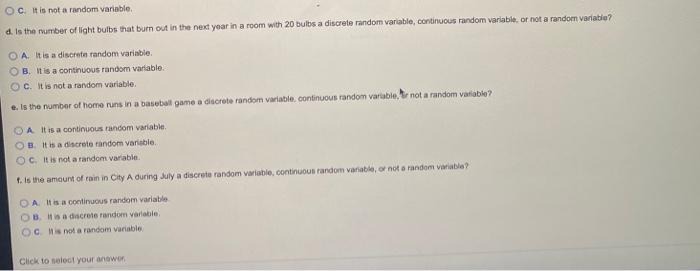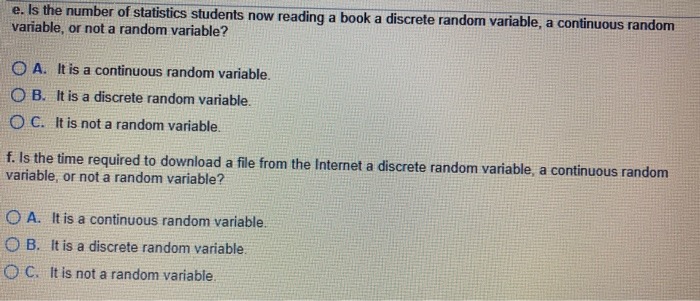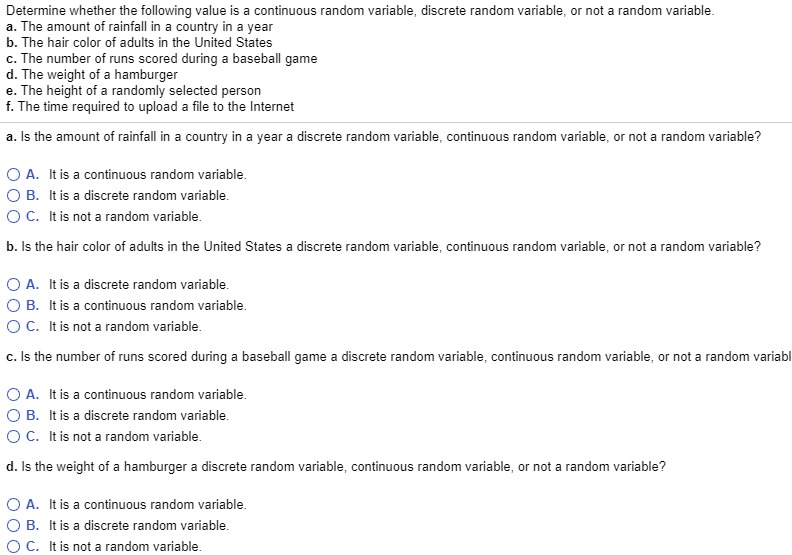4.How many possible outcomes are there if we toss 10 dice, each of a different color?
N =
possible outcomes
5.The following exercise refers to choosing two cards from a thoroughly shuffled deck. Assume that the deck is shuffled after a card is returned to the deck.
If you do not put the first card back in the deck before you draw the next, what is the probability that the first card is a heart and the second card is a spade? (Enter your probability as a fraction.)
6.Suppose that a certain HIV test has both a sensitivity and specificity of 99.9%. This test is applied to a population of 1,000,000 people.
Suppose that the population comes from the blood donor pool that has already been screened. In this population, 0.3% of the population is actually infected with HIV.
(a) Calculate the PPV. Suggestion: First make a table as seen below. (Round your answer to one decimal place.)
%
Has disease Does not have disease Totals
Test positive
Test negative
Totals
(b) Calculate the NPV. (Round your answer to four decimal places.)
%
(c) How many people will test positive who are, in fact, disease-free?
Determine whether the following value is a continuous random variable, discrete randorn variable, or not a random variable. 4. The number of textbook authors now eating a meal b. The "yes" or "no" response to a survey question c. The height of a randomly selected person d. The number of light bulbs that burn out in the next year in a room with 20 bulbs e. The number of home runs in a baseball game f. The amount of rain in City A during July a. is the number of textbook authors now eating a meal a discrete random variable, continuous random variable, or not a random variable? O A. It is a continuous random variable Q B. It is a discrete random variable. O C. It is not a random variable b. is the "you" or "no" response to a survey question a discrole random variable, continuous random variable, or not a random variable? Q A It is a discrete random variable. O B, It is a continuous random variable, C. it is not a random variable. c. is the height of a randomly selected person a discrete random variable, continuous random variable, or not a random valable? A. it is a discrete random variable. B. It is a continuous random variable. C C. it is not a random variable d. is the number of light bulbs that burn out in the next year in a room with 20 bulbs a cincrete random variable, continuous random variable, or not a random variable7 O A It is a discrete random variable,O C. It is not a random variable, d. is the number of light bulbs that burn out in the next year in a room with 20 bulbs a discrete random variable, continuous random variable, or not a random variation O A. It is a discreta random variable. B. It is a continuous random variable. O C. It is not a random variable. e. Is the number of home runs in a baseball game a discrete random variable, continuous random variable. Is not a random vatlabia? A it is a continuous random variable. O'B. it is a discrete fandom variable. O C. It is not a random variable. 1. Is the amount of ram in City A during July a discrete random variable, continuous random venable, of not a random variable? D) A. It is a continuous random variable B. In a dncrete random vadable. OG. his not a random variable Click to select your answere. Is the number of statistics students now reading a book a discrete random variable, a continuous random variable, or not a random variable? O A. It is a continuous random variable O B. It is a discrete random variable. O C. It is not a random variable. f. Is the time required to download a file from the Internet a discrete random variable, a continuous random variable, or not a random variable? O A. It is a continuous random variable. O B. It is a discrete random variable C. It is not a random variableDetermine whether the following value is a continuous random variable, discrete random variable, or not a random variable. a. The amount of rainfall in a country in a year b. The hair color of adults in the United States c. The number of runs scored during a baseball game d. The weight of a hamburger e. The height of a randomly selected person f. The time required to upload a file to the Internet a. Is the amount of rainfall in a country in a year a discrete random variable, continuous random variable, or not a random variable? O A. It is a continuous random variable. O B. It is a discrete random variable. O C. It is not a random variable. b. Is the hair color of adults in the United States a discrete random variable, continuous random variable, or not a random variable? O A. It is a discrete random variable. O B. It is a continuous random variable. O C. It is not a random variable. c. Is the number of runs scored during a baseball game a discrete random variable, continuous random variable, or not a random variab O A. It is a continuous random variable. O B. It is a discrete random variable. O C. It is not a random variable. d. Is the weight of a hamburger a discrete random variable, continuous random variable, or not a random variable? O A. It is a continuous random variable. O B. It is a discrete random variable. O C. It is not a random variable










